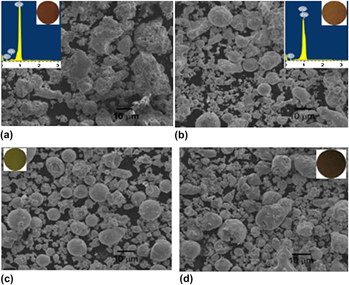Article contents
Chemical and morphological characterization of spherical Cu/Zn alloy microparticles produced by combustion synthesis
Published online by Cambridge University Press: 13 September 2012
Abstract

Copper–zinc alloy (Cu/Zn) powders with different Zn to Cu molar ratios were prepared by the combustion synthesis technique using a CuO + 0.15(C2H4)n + kZn (0.2 ≤ k ≤ 1.6 mol) reactive mixture. Depending on the Zn concentration, the combustion wave developed a temperature between 950 and 1040 °C and passed through the sample with a speed of 0.04–0.08 cm/s, resulting in almost single-stage temperature distributions. Cu/Zn alloy powders with Zn concentrations ranging from 0.5 to 45 wt% were obtained. It was shown that alloy particles become spherical and well dispersed with increasing Zn concentration. Inert dilution test with KCl salt was also performed to determine the influence of temperature degradation in the combustion wave on the morphology and composition of alloy powders.
- Type
- Articles
- Information
- Copyright
- Copyright © Materials Research Society 2012
References
REFERENCES
- 1
- Cited by




